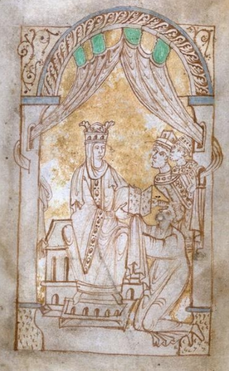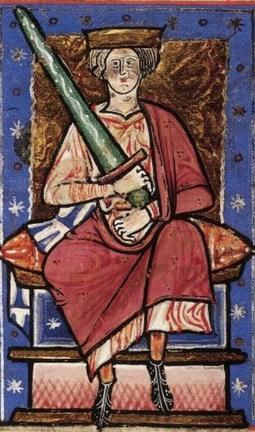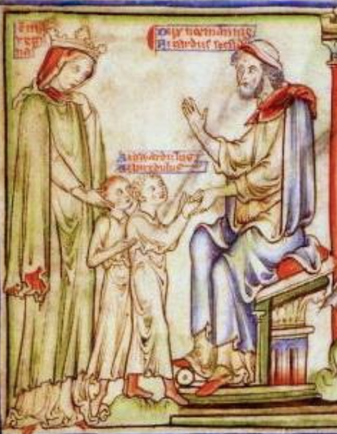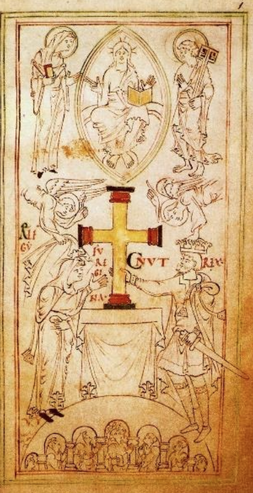|
If you could invite anyone to a historical dinner party, who would you invite? Well top of my list would be the powerful Emma of Normandy, one of the last Queens of England before the Norman Conquest. Emma was born in around the 980s to Richard the Fearless, Duke of Normandy and his second wife Gunnar. She would have had a privileged upbringing as the daughter of a Duke, but she was still very much a woman in a man’s world. There were very few ways women could have autonomy in Europe’s patriarchal societies, and many were sidelined to the domestic sphere. The only way for women to wield power was through her connection with a man. In 1002, to secure an alliance between Normandy and England, Emma became the wife of King Æthelred of England who was later given the unkind but accurate moniker ‘the unready’. Emma was his second wife, as Æthelred had previously been married to Ælfgifu of York with whom he had at least 10 children with. Emma’s position as second wife of a king with plenty of heirs was not exactly ideal, as Emma would want her own children to succeed Æthelred. However, a consolation prize was that unlike her predecessor Emma was actually crowned as Queen. England at this time was suffering from Viking invasions and were without a strong leader (sorry Æthelred). In 1013 things came to a head and the Viking King of Denmark Sweyn Forkbeard conquered the country. Emma had to flee to her native Normandy with her three children Edward, Alfred and Godgifu. The next few years were intense for Emma and involved a lot of changes to who sat on the English throne. In 1014 Sweyn Forkbeard died and Æthelred returned to the throne before dying himself in April 1016 leaving Emma widowed and a Dowager Queen. Her step-son Edmund Ironside inherited the throne, fighting and then reconciling with Cnut (Sweyn’s son) and they separated parts of the kingdom with Edmund taking Wessex and Cnut Mercia. However, Edmund died only a few months after his father in November 1016 leaving the whole of England in Cnut’s grasp. During this time Emma’s position would have been unclear. According to the chronicler William of Malmesbury she didn’t have a close relationship with her husband, but ultimately his death did affect her political standing and weakened her position (temporarily as we’ll see). Her step-son was then king but that only served to emphasis the downsides of being a second wife, as her elder son Edward was not Æthelred’s heir. Her position changed radically though when she married Cnut. Yes folks, Emma married the Viking king in 1017. As reported in the Anglo-Saxon Chronicle “before August 1st the king commanded brought to him the widow of the other king, Æthelred, Richard’s daughter, that he might have her as his Queen”. This doesn’t paint a picture that Emma had much choice in the matter, they don’t even name her, just talk about her through her first husband and father. However, marrying Cnut was a politically good move. Their marriage was much more successful than her first, and she had a much more significant role in the Anglo-Danish court. Not only was she Queen of England but also Queen of Cnut’s other domains of Norway and Denmark which made up the North Sea Empire. Emma and Cnut agreed to favour children from their marriage over any they had from their previous marriages. Understandably Emma did not want to repeat history by being a second wife whose children weren’t considered heirs, but she effectively disinherited Edward and Alfred. Although this seems harsh, did she really have much choice? Cnut wasn’t going to let them inherit the throne, and they could be seen as future rivals to be destroyed. Although it doesn’t appear like it on the surface, Emma’s marriage did protect the lives of her two sons by Æthelred even if it undermined their political positions. Emma and Cnut had two children: Harthacnut and Gunhilda. When Cnut died suddenly in 1035, Harthacnut was meant to inherit the throne but he was away in the North in their other domains. It was decided Emma would be Regent alongside Earl Godwin of Wessex and Harthacnut’s half-brother Harold Harefoot who was Cnut’s son by his first wife Elgiva. Was Harold happy with this arrangement? Of course not, he wanted the throne for himself, and as Harthacnut was taking his sweet time returning to England, Harold looked to seized his chance. Emma must have known her position as regent although powerful was ultimately fragile, if she lost the support of Harold and Godwin there wouldn’t be a lot she could do to protect Harthacnut’s throne. In 1036 she invited her sons Edward and Alfred to join her in England (they were still in Normandy) which led to one of the most tragic moments of Emma’s life, when her younger son Alfred was taken by her supposed ally Earl Godwin and blinded, subsequently dying of his wounds. Edward escaped such a fate as he wasn’t able to land in England. After this betrayal unfolded Harold made his move and in 1037, as recounted in the Anglo-Saxon Chronicle, “was chosen over all as king; Harthacnut was forsaken because he was too long in Denmark”. This was a bleak time for Emma, she travelled to Flanders where she was received by Earl Baldwin. By 1040 Harthacnut planned to reclaim his throne from his erstwhile brother, but Harold (conveniently for him) died so Harthacnut could sail peacefully into England and take up his throne. As mother of the king, Emma’s position was restored. After seeing 5 kings on the English throne, finally it was her beloved son who took up the mantle although he was not a popular king. Edward, after many long years of exile, was recalled into England and named as Harthacnut’s co-ruler. Presumably this may have been the work of Emma who wanted extra support, and perhaps they already knew at this stage the childless Harthacnut didn’t have long left. Harthacnut died in 1042 with Edward becoming King of England, later known as Edward the Confessor. Edward was, quite understandably, not Emma’s biggest fan. Even if it was to protect him, she ultimately disinherited him when she married Cnut, and he may have blamed her for the death of his brother Alfred. Edward took away a lot of her land and wealth, although this was later returned to her. This was the beginning of the end of her political career though, and she died in 1052 aged 68.
Emma led a remarkable life, and she left an even more remarkable legacy. In her lifetime she commissioned the Encomium Emmae Reginae, likely during Harthacnut’s reign. An incredibly biased account of contemporary events, the first copy omitted Æthelred completely. This was re-written though when Emma and Æthelred’s son Edward came to the throne. Emma’s more unintentional legacy though was the 1066 Norman Conquest. Her great-nephew William of Normandy through his familial connection with her and Edward the Confessor believed he had a legitimate claim to the throne and believed it was promised to him in around 1051. After Harold Godwinson’s accession in 1066, William launched the Norman Invasion of England which changed the face of England forever. Sources ODNB: Emma [Ælfgifu] by Simon Keynes ODNB: Æthelred II by Simon Keynes Kings & Queens: The Story of Britain’s Monarchs from Pre-Roman Times to Today by Richard Cavendish and Pip Leahy The Anglo-Saxon Chronicle: The Authentic Voices of England From the Time of Julius Caesar to the Coronation of Henry II. Translated and Collated by Anne Savage. The Normans in Europe by Elizabeth Van Houts Memory and Gender in Medieval Europe, 900-1200 By Elizabeth Van Houts Silk and the Sword: The Women of the Norman Conquest by Sharon Bennett Connolly Rex Factor Podcast S.3.14 Emma of Normandy British Library: Emma of Normandy British Library: Encomium Emmae reginae Wikipedia:
1 Comment
|
Categories
All
Archives
April 2024
|






 RSS Feed
RSS Feed